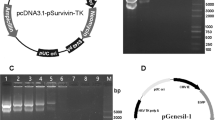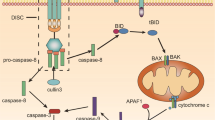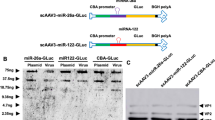Abstract
Local and locoregional administration of adenovectors expressing the tumor necrosis factor-related apoptosis-inducing ligand (TRAIL) gene has been demonstrated to be useful in treating established tumors in animals. Moreover, expression of the TRAIL gene from the human telomerase reverse transcriptase (hTERT) promoter can be used to prevent possible liver toxicity of the TRAIL gene. However, it remains unknown whether systemic administration of the TRAIL-expressing adenovector can be used for cancer therapy. Here, we showed that a combination of TRAIL gene therapy and gemcitabine, the first-line chemotheraphy agent for pancreatic cancer, had a synergistic effect on the induction of apoptosis in human pancreatic cancer cell lines in vitro. Systemic administration of an adenovector that contains an insertion of integrin-binding motif argine-glycine-aspartate (RGD) in the HI loop of the adenoviral fiber protein and expresses the human TRAIL gene from the hTERT promoter (designated Ad/TRAIL-F/RGD) suppressed the growth of human pancreatic tumor cells inoculated in the liver of nu/nu nude mice. Furthermore, Ad/TRAIL-F/RGD in combination with gemcitabine suppressed the tumor growth of pancreatic cancer in the liver more than did treatments consisting of each agent alone. No obvious liver toxicity was detected in any of the treatment groups. Our results suggest that TRAIL gene therapy in combination with gemcitabine might be a useful therapeutic approach for treating metastatic pancreatic cancers.
This is a preview of subscription content, access via your institution
Access options
Subscribe to this journal
Receive 12 print issues and online access
$259.00 per year
only $21.58 per issue
Buy this article
- Purchase on Springer Link
- Instant access to full article PDF
Prices may be subject to local taxes which are calculated during checkout



Similar content being viewed by others
References
Blaszkowsky L . Treatment of advanced and metastatic pancreatic cancer. Front Biosci. 1998;3:E214–E225.
Shi X, Friess H, Kleeff J, et al. Pancreatic cancer: factors regulating tumor development, maintenance and metastasis. Pancreatology. 2001;1:517–524.
Kulke MH . Metastatic pancreatic cancer. Curr Treat Option Oncol. 2002;3:449–457.
Tsai JY, Iannitti DA, Safran H . Combined modality therapy for pancreatic cancer. Seminar Oncol. 2003;30:71–79.
Bardeesy N, DePinho RA . Pancreatic cancer biology and genetics. Nat Rev Cancer. 2002;2:897–909.
Bouvet M, Bold RJ, Lee J, et al. Adenovirus-mediated wild-type p53 tumor suppressor gene therapy induces apoptosis and suppresses growth of human pancreatic cancer. Ann Surg Oncol. 1998;5:681–688.
Pearson AS, Bouvet M, Evans DB, et al. Gene therapy and pancreatic cancer. Front Biosci. 1998;3:E230–E237.
Katz MH, Spivack DE, Takimoto S, et al. Gene therapy of pancreatic cancer with green fluorescent protein and tumor necrosis factor-related apoptosis-inducing ligand fusion gene expression driven by a human telomerase reverse transcriptase promoter. Ann Surg Oncol. 2003;10:762–772.
Gu J, Kagawa S, Takakura M, et al. Tumor-specific transgene expression from the human telomerase reverse transcriptase promoter enables targeting of the therapeutic effects of the Bax gene to cancers. Cancer Res. 2000;60:5359–5364.
Lin T, Gu J, Zhang L, et al. Targeted expression of green fluorescent protein/Tumor necrosis factor-related apoptosis-inducing ligand fusion protein from human telomerase reverse transcriptase promoter elicits antitumor activity without toxic effect on primary human hepatocytes. Cancer Res. 2002;62:3620–3625.
Dmitriev I, Krasnykh V, Miller CR, et al. An adenovirus vector with genetically modified fibers demonstrates expanded tropism via utilization of a coxsackievirus and adenovirus receptor-independent cell entry mechanism. J Virol. 1998;72:9706–9713.
Wickham TJ, Tzeng E, Shears LL, et al. Increased in vitro and in vivo gene transfer by adenovirus vectors containing chimeric fiber proteins. J Virol. 1997;71:8221–8229.
Jacob DA, Davis JJ, Zhu H, et al. Suppressing orthotopic pancreatic tumor growth with a fiber-modified adenovector expressing the TRAIL gene from the hTERT promoter. Clin Cancer Res. 2004;10:3535–3541.
Fang B, Roth JA . The role of gene therapy in combined modality treatment strategies for cancer. Curr Opin Mol Ther. 2003;5:475–482.
Fang B, Ji L, Bouvet M, et al. Evaluation of GAL4/TATA in vivo. Induction of transgene expression by adenovirally mediated gene codelivery. J Biol Chem. 1998;273:4972–4975.
Kagawa S, He C, Gu J, et al. Antitumor activity and bystander effects of the tumor necrosis factor-related apoptosis-inducing ligand (TRAIL) gene. Cancer Res. 2001;61:3330–3338.
Kavolius J, Fong Y, Blumgart LH . Surgical resection of metastatic liver tumors. Surg Oncol Clin North Am. 1996;5:337–352.
McCarter MD, Fong Y . Metastatic liver tumors. Seminar Surg Oncol. 2000;19:177–188.
Hosch SB, Steffani KD, Scheunemann P, et al. Micrometastases from HBP malignancies and metastatic cancer. J Hepato-Biliary-Pancreatic Surg. 2002;9:583–591.
Charnsangavej C, Loyer EM, Iyer RB, et al. Tumors of the liver, bile duct, and pancreas. Curr Prob Diagn Radiol. 2000;29:69–107.
Paulson EK . Evaluation of the liver for metastatic disease. Semin Liver Dis. 2001;21:225–236.
Keane MM, Ettenberg SA, Nau MM, et al. Chemotherapy augments TRAIL-induced apoptosis in breast cell lines. Cancer Res. 1999;59:734–741.
Lin T, Zhang L, Davis JJ, et al. Combination of TRAIL gene therapy and chemotherapy enhanced anti-tumor and anti-metastasis effects in chemosensitive and chemoresistant breast cancers. Mol Ther. 2003;8:441–448.
Cuello M, Ettenberg SA, Nau MM, et al. Synergistic induction of apoptosis by the combination of trail and chemotherapy in chemoresistant ovarian cancer cells. Gyn Oncol. 2001;81:380–390.
Liu W, Bodle E, Chen JY, et al. Tumor necrosis factor-related apoptosis-inducing ligand and chemotherapy cooperate to induce apoptosis in mesothelioma cell lines. Am J Resp Cell Mol Biol. 2001;25:111–118.
Matsuzaki H, Schmied BM, Ulrich A, et al. Combination of tumor necrosis factor-related apoptosis-inducing ligand (TRAIL) and actinomycin D induces apoptosis even in TRAIL-resistant human pancreatic cancer cells. Clin Cancer Res. 2001;7:407–414.
Xu ZW, Kleeff J, Friess H, et al. Synergistic cytotoxic effect of TRAIL and gemcitabine in pancreatic cancer cells. Anticancer Res. 2003;23:251–258.
Nagane M, Pan G, Weddle JJ, et al. Increased death receptor 5 expression by chemotherapeutic agents in human gliomas causes synergistic cytotoxicity with tumor necrosis factor-related apoptosis-inducing ligand in vitro and in vivo. Cancer Res. 2000;60:847–853.
Yamanaka T, Shiraki K, Sugimoto K, et al. Chemotherapeutic agents augment TRAIL-induced apoptosis in human hepatocellular carcinoma cell lines. Hepatology. 2000;32:482–490.
Gibson SB, Oyer R, Spalding AC, et al. Increased expression of death receptors 4 and 5 synergizes the apoptosis response to combined treatment with etoposide and TRAIL. Mol Cell Biol. 2000;20:205–212.
Yoon SK, Armentano D, Wands JR, et al. Adenovirus-mediated gene transfer to orthotopic hepatocellular carcinomas in athymic nude mice. Cancer Gene Ther. 2001;8:573–579.
Croyle MA, Chirmule N, Zhang Y, et al. “Stealth” adenoviruses blunt cell-mediated and humoral immune responses against the virus and allow for significant gene expression upon readministration in the lung. J Virol. 2001;75:4792–4801.
O'Riordan CR, Lachapelle A, Delgado C, et al. PEGylation of adenovirus with retention of infectivity and protection from neutralizing antibody in vitro and in vivo. Hum Gene Ther. 1999;10:1349–1358.
Siemens DR, Elzey BD, Lubaroff DM, et al. Cutting edge: restoration of the ability to generate CTL in mice immune to adenovirus by delivery of virus in a collagen-based matrix. J Immunol. 2001;166:731–735.
Yotnda P, Chen DH, Chiu W, et al. Bilamellar cationic liposomes protect adenovectors from preexisting humoral immune responses. Mol Ther. 2002;5:233–241.
Acknowledgements
We thank Gayle Nesom for editorial review and Jesse Null and Alma Vega for assistance in preparing the manuscript. This article represents partial fulfillment of the requirements for the PhD degree for JJD. This work was supported in part by the National Cancer Institute/National Institute of Health (RO1 CA 092487-01A1, RO1 CA 098582-01A1 (to BF) and Core Grant CA 16672) and by Lockton Grant Matching Program.
Author information
Authors and Affiliations
Corresponding author
Rights and permissions
About this article
Cite this article
Jacob, D., Davis, J., Zhang, L. et al. Suppression of pancreatic tumor growth in the liver by systemic administration of the TRAIL gene driven by the hTERT promoter. Cancer Gene Ther 12, 109–115 (2005). https://doi.org/10.1038/sj.cgt.7700773
Received:
Published:
Issue Date:
DOI: https://doi.org/10.1038/sj.cgt.7700773
Keywords
This article is cited by
-
Low-dose gemcitabine induces major histocompatibility complex class I-related chain A/B expression and enhances an antitumor innate immune response in pancreatic cancer
Clinical and Experimental Medicine (2017)
-
TRAIL-engineered pancreas-derived mesenchymal stem cells: characterization and cytotoxic effects on pancreatic cancer cells
Cancer Gene Therapy (2012)
-
Cisplatin enhances the antitumor effect of tumor necrosis factor-related apoptosis-inducing ligand gene therapy via recruitment of the mitochondria-dependent death signaling pathway
Cancer Gene Therapy (2008)
-
The histone deacetylase inhibitors depsipeptide and MS-275, enhance TRAIL gene therapy of LNCaP prostate cancer cells without adverse effects in normal prostate epithelial cells
Cancer Gene Therapy (2007)
-
Cancer gene therapy using a novel secretable trimeric TRAIL
Gene Therapy (2006)



